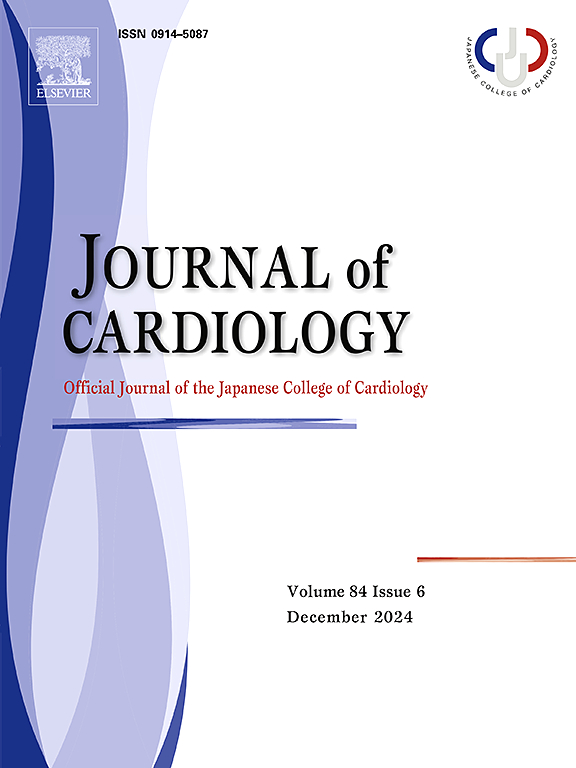脂肪组织沉积与心脏再同步治疗反应和临床结果的关系:CRT-HF诊所子研究。
IF 2.5
3区 医学
Q2 CARDIAC & CARDIOVASCULAR SYSTEMS
引用次数: 0
摘要
背景:脂肪沉积区域是影响心力衰竭(HF)患者预后的重要决定因素。然而,区域性脂肪对接受心脏再同步化治疗(CRT)的心衰患者的影响仍不清楚:我们对一项单中心研究中的 95 名患者进行了回顾性队列分析,评估了 CRT 治疗后的效果。CRT置入前胸部计算机断层扫描的多切片身体成分测量用于脂肪定量。根据皮下脂肪含量、肌肉内脂肪含量和肝脏脂肪变性对患者进行分层:皮下脂肪含量与较高的 CRT 反应率相关(皮下脂肪含量高的患者反应率为 44.4%,皮下脂肪减少的患者反应率为 16.7%,P = 0.009),而肌肉内脂肪含量与虚弱前期的增加相关(调整后 OR 为 14.17,95 % CI 为 2.24-89.57,P = 0.005)。皮下脂肪过多的患者对 CRT 的反应较高,这可能是因为皮下脂肪沉积优于异位脂肪沉积,而异位脂肪沉积对心肌细胞功能障碍具有潜在的保护作用。因此,肌肉内脂肪含量有可能成为衡量高频患者虚弱程度的预后工具。本文章由计算机程序翻译,如有差异,请以英文原文为准。
Associations of adipose tissue depots with cardiac resynchronization therapy response and clinical outcomes: A CRT-HF Clinic substudy
Background
The region of adipose deposition is an important determinant in the outcomes of patients with heart failure (HF). However, the impact of regional adiposity on HF patients undergoing cardiac resynchronization therapy (CRT) remains unclear.
Methods
A retrospective cohort analysis was conducted on 95 patients from a single-center study, assessing post-CRT outcomes. Multi-slice body composition measurements of chest computed tomography before CRT placement were used for adipose quantification. Patients were stratified based on subcutaneous adiposity, intramuscular adiposity, and hepatic steatosis.
Results/Conclusion
Subcutaneous adiposity correlated with higher CRT response rates (44.4 % in subcutaneous adiposity vs 16.7 % in subcutaneous adipopenia, p = 0.009), while intramuscular adiposity was associated with increased pre-frailty (adjusted OR 14.17, 95 % CI 2.24–89.57, p = 0.005). The higher response to CRT in patients with subcutaneous adiposity may be secondary to preferred subcutaneous over ectopic adipose fat deposition, which is potentially protective against cardiomyocyte dysfunction. Thus, intramuscular adiposity could potentially serve as a prognostic tool for frailty in HF patients.
求助全文
通过发布文献求助,成功后即可免费获取论文全文。
去求助
来源期刊

Journal of cardiology
CARDIAC & CARDIOVASCULAR SYSTEMS-
CiteScore
4.90
自引率
8.00%
发文量
202
审稿时长
29 days
期刊介绍:
The official journal of the Japanese College of Cardiology is an international, English language, peer-reviewed journal publishing the latest findings in cardiovascular medicine. Journal of Cardiology (JC) aims to publish the highest-quality material covering original basic and clinical research on all aspects of cardiovascular disease. Topics covered include ischemic heart disease, cardiomyopathy, valvular heart disease, vascular disease, hypertension, arrhythmia, congenital heart disease, pharmacological and non-pharmacological treatment, new diagnostic techniques, and cardiovascular imaging. JC also publishes a selection of review articles, clinical trials, short communications, and important messages and letters to the editor.
 求助内容:
求助内容: 应助结果提醒方式:
应助结果提醒方式:


